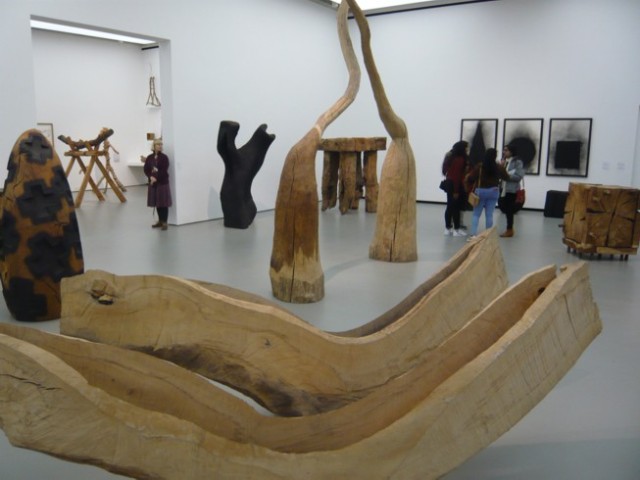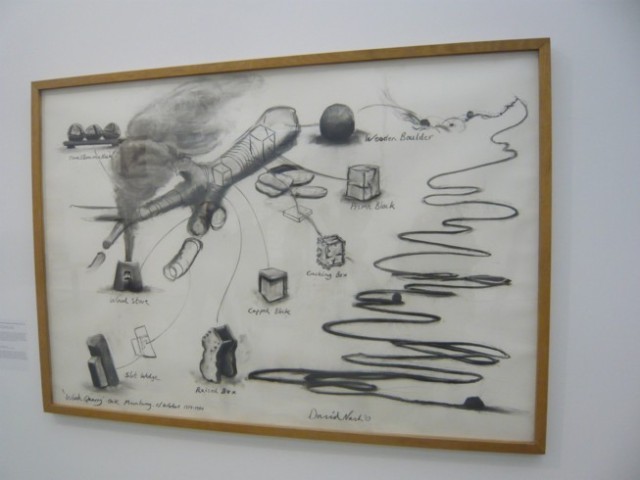A few days ago we went to the Towner Gallery in Eastbourne, Sussex, specifically to see the Eric Ravilious paintings and prints on permanent exhibition there. There was also a large exhibition by the sculptor David Nash, who works with wood on a large scale. The fact that the whole exhibition, which also included a gallery of paintings, prints and a couple of small installations, and was intended to highlight the effects of the Climate Crisis, was the first one ever curated by Caroline Lucas M.P. of the Green Party was an added bonus for me.


As much as I enjoyed the Ravilious, I was blown away by Nash’s sculptures. To see wooden sculptures on that scale is unusual in itself – usually that would be the preserve of stone or metal – but that very scale plays tricks with the mind and the eye. Boxes and bowls many times larger than one would expect meet the eye as you walk around the galleries, and many of the pieces also deceive where perhaps one looks to be made from several separate pieces of wood, but on closer inspection are carved from a single block like the boat shapes in the top picture, or the ‘stack’ in the one below that.
Much of the work is left rough-hewn, but even this can be deceptive. Some pieces have been carefully finished to give that appearance.
Sculpture is the art form that seems to exist to interact with the natural world. A number of the works here are based on natural forms, but there are also stories of projects Nash has undertaken where his sculpture is either living, in the form of carefully planted and managed groves of trees, or interact in other ways.

‘Boulder’ is one such project. One of the first large-scale pieces Nash made was to cut a boulder-shaped chunk from a tree (illustrated at the top of Nash’s charcoal drawing above) in 1978. This was then transported to a stream near to where he lives and works, in the Welsh hills, and rolled into the water. Since then, it has slowly made its way downstream until it reached the estuaries and inlets of the sea, where it finally disappeared in 2015. Nash documented its travels in a series of photographs and films made regularly all the while, and presented in the exhibition as a film.



Nash’s sketch of a Larch trunk
It feels as though there is something of this meeting of art and the natural world in old ruins overrun with scrub and grass. They frequently seem to have a sculptural quality that complements the landscape around them, in a way that more pristine buildings do not.
And I like the sense that an artwork, like a ruined building, is not permanent and that eventually the natural world will absorb it back into itself. That it will reclaim it. Perhaps the artist and the environmentalist in me merge here.
My own sculptures are in wood, and some of them are set out in our garden where they gradually degrade over the years through the action of sun and rain, until they appear strangely like some weird plants that have sprouted unexpectedly there.

What a fascinating exhibition, I love wood and the possibilities for a sculptor are endless. I think I’ve only been to Eastbourne a couple of times and didn’t know it had a gallery.
LikeLiked by 2 people
It’s a really good gallery, and entrance is free, too! They ask for donations.
LikeLiked by 1 person
We are lucky to have so many galleries that are free, from Tate Modern to Turner Contemporary in Margate ( which we know well as our daughter and family live in Margate! ).
LikeLiked by 1 person
Yes, that’s another one within fairly easy reach of us.
LikeLiked by 1 person
Mick, what a fantastic added bonus and I too love wooden sculptures! Nash’s work is phenomenal and it’s great how he’s added the process of the creative journey! I imagine you came away very inspired and with lots of ideas for your own art!
LikeLiked by 2 people
I certainly had a few, Annika.
LikeLiked by 1 person
I too love wooden sculptures. Generally people are encouraged to touch them which adds to the patina. My medium is clay and those babies once fired do just fine outside!
LikeLiked by 2 people
There were signs up asking people not to touch, although I suspect that was more to do with the worry that a piece might be knocked over.
I’ve dabbled in clay, but only making pots. Do you sculpt in clay?
LikeLiked by 1 person
I used to. My wrists gave out about 10 years ago and handling wet clay is too painful.
LikeLiked by 2 people
Yes, it’s heavy stuff!
LikeLike
Really incredible work. Wonderful that you had the chance to see it in person! Happy New Year, Mick!
LikeLiked by 2 people
It was a great exhibition, Meg. Happy New Year to you, too.
LikeLiked by 1 person
Awesome wooden art and thanks for taking us on this wonderful exhibition, Mick. Too good.
LikeLiked by 2 people
You’re welcome, Kamal. I’m glad you enjoyed it.
LikeLike
Yes Mick. 😊😊😊😊😊
LikeLiked by 1 person
What a fascinating exhibition Mick. Sculpture, especially in wood, is just so impressive as you can actually see and appreciate the work put in to create the finished piece. Love the way they look rough-finished too. Gives them a natural feel doesn’t it? So interesting.
LikeLiked by 2 people
It’s quite a while since I’ve been so impressed by work from someone I see for the first time, Jonno.
LikeLiked by 1 person
You guide us through this beautiful display with the eye for detail and personal engagement of a practitioner. An inspiring read, Mick!
LikeLiked by 2 people
Thanks, Dave. I’m glad you liked it.
LikeLiked by 1 person
loved those sculptures! thanks for sharing 🙂
LikeLiked by 2 people
You’re welcome!
LikeLiked by 1 person
That gives a whole new meaning to woodworking. Although I suspect the native carvers of totem poles, or the chain saw artists, or others of the ilk would just say welcome cousin. As for me, mashed potatoes is about as far as I go with sculpting, and that’s always transient.
LikeLiked by 2 people
I never had you down as a mashed potato artist, Dave. Have you had any exhibitions?
LikeLike
This sounds (and looks) like it was a good exhibit to see. Your last three paragraphs – about the idea of ruins having the feeling of sculptures, impaermanance being built into artworks and your own work – I resonate with all of it. 🙂
LikeLiked by 1 person
It was highly impressive. And I’m glad you like that.
LikeLiked by 1 person
I have nominated you for the sunshine Bloggers award…https://wp.me/pbxGbo-7o
LikeLiked by 1 person
Thanks, Anurika, but this is a no awards blog. I hope you’ll understand.
LikeLiked by 1 person
It’s totally okay.
Consider it a little appreciation.🍀
LikeLiked by 1 person
I do! Thank you very much!
LikeLiked by 1 person